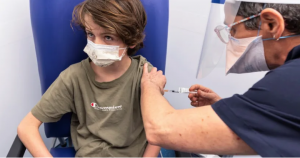The Infectious Myth Busted Part 4: Is Measles Contagious?
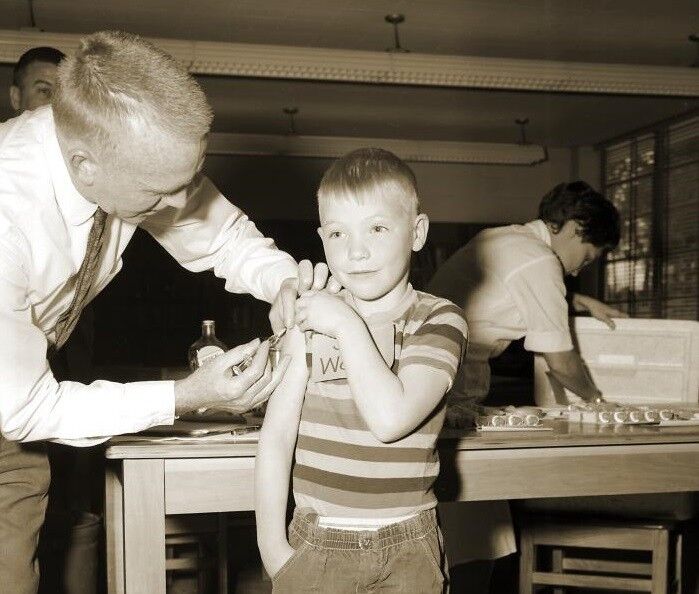
“A careful search of the literature does not reveal a case in which the blood from a patient having measles was injected into the blood
stream of another person and produced measles.”-Harry Bauguess
doi:10.1001/archpedi.1924.01920090061007
I want to begin by thanking Daniel Roytas of Humanley.com for his amazing research skills. I worked from his outline of the measles transmission experiments in order to present the information for this article. He has a gift for finding the studies and reviews that the pharmaceutical cartel does not want people to know about. Please visit his site for excellent podcasts and information.
Measles is always a hot topic of discussion that continues to divide people. The disease gained notoriety as a killer of children, and anytime children are involved, tempers flare. The pharmaceutical industry has done a remarkable job of convincing the majority that the symptoms known as measles are a deadly disease requiring vaccination in order to protect the children and all those around them, especially the “immunocompromised.” A massive vaccination campaign that began in 1963 created the perception that the vaccine was responsible for a drop in childhood deaths from the disease, even though the statistics show that it had no such effect as the death rate had plummeted long before vaccines were introduced.
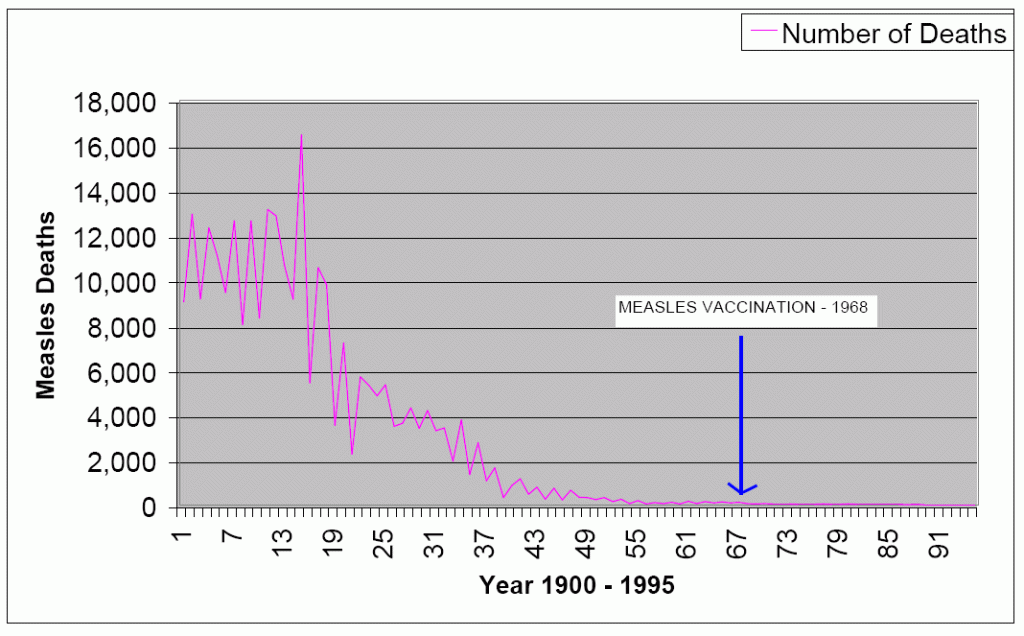
In fact, in the past, doctors would regularly speak of measles as a mild childhood disease that did not lead to death or even require medication for recovery. In an 1860 address to the Smithsonian Institute, Dr. R.T. Trail made amazing claims about the benign nature of measles and several other diseases:
“I have myself, through Natural Hygiene, over 16 years, treated all forms and hundreds of cases of typhus and typhoid fevers, pneumonia’s, measles and dysentery’s, and have not lost a single patient. The same is true of scarlet and other fevers. No medicine whatever was given.”
-R.T. Trall M.D. http://www.whale.to/v/trall.htm
In the 1959 Vital Statistics published in the British Medical Journal,measles was considered a very mild disease that had few serious complications:
‘In the majority of children the whole episode has been well and truly over in a week . . . In this practice measles is considered as a relatively mild and inevitable childhood ailment that is best encountered any time from 3 to 7 years of age. Over the past 10 years there have been few serious complications at any age, and all children have made complete recoveries. As a result of this reasoning no special attempts have been made at prevention even in young infants in whom the disease has not been found to be especially serious.” — Vital Statistics, British Medical Journal, February 7 1959, p. 381
http://whale.to/m/measles1.html
In 1962, a year before the measles vaccine was introduced, Dr. Alexander Langmuir, the CDC’s chief disease detective who created and led the epidemiology surveillance unit from 1949 to 1970, granting him the title of the “father of infectious disease epidemiology,” wrote that measles was an “infection” of short duration, moderate severity, and low fatality:
The Importance of Measles as a Health Problem
“This self-limiting infection of short duration, moderate severity, and low fatality has maintained a remarkably stable biological balance over the centuries.”
In 1998, Pamela Dyne, Associate Residency Director, Assistant Professor of Medicine, Department of Emergency Medicine, Olive View-UCLA Medical Center, stated in an emedicine.com article that measles was usually benign and uncomplicated:
Pediatrics, Measles
“Although a clinically significant viral illness, measles is usually benign and uncomplicated. Complications occur more commonly in adults and in children who are undernourished or immunocompromised.”
https://web.archive.org/web/19980702034411/http://www.emedicine.com/emerg/topic389.htm
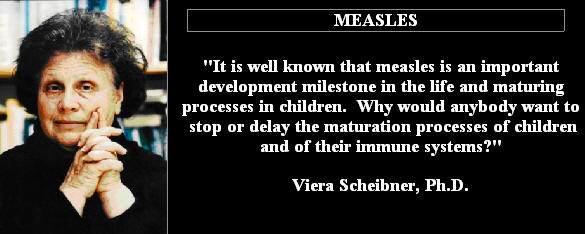
As is usually the case, the people and sources stating that measles is not a deadly disease were either ignored and/or forgotten. Studies and whistleblowers that alerted the public to the dangerous and deadly consequences of the vaccines were conveniently swept under the rug. A successful pharmaceutical propaganda campaign has convinced the public that the vaccines save lives and that this highly contagious disease has been largely controlled. Any sudden outbreaks are considered a disease of the unvaccinated and a direct result of their “anti-scientific” ways. The unvaccinated are seen as a walking threat, as “deadly and contagious” as the disease itself.
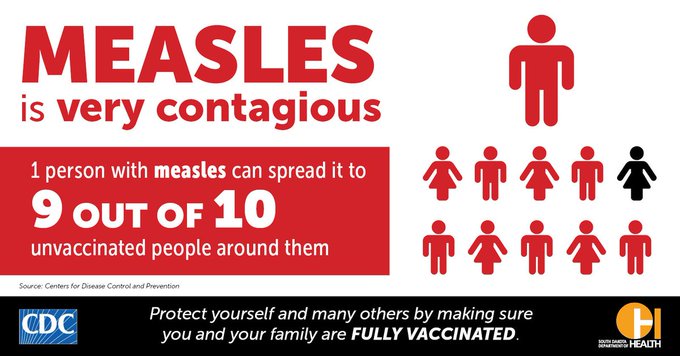
According to the New England Medical Journal, measles is one of the most highly contagious pathogens known to man. It states that, in a 100% susceptible population, a single case of measles results in 12 to 18 secondary cases on average. The WHO concurs with the NEJM in that the measles is one of the worlds most highly contagious “viral” diseases and that it can lead to severe complications and death in the unvaccinated. According to the CDC, if one person has the measles, 90% of the people next to that person who are not “immune” will become “infected.”
These are some rather scary sounding claims for a “viral” disease that was once considered an inevitable, mild, benign, and uncomplicated disease of moderate severity and low fatality. This raises some very interesting questions. Do the claims of the measles “virus” being a highly contagious disease actually hold up when reviewing the literature? Was this super “infectious” disease able to be successfully transmitted from the fluids of a sick host into either a healthy human or animal subject? Were researchers actually able to recreate the exact same disease experimentally? If we are to judge the “highly contagious” nature of this “virus” based upon the attempted transmission experiments throughout the 19th and 20th centuries involving the use of the blood, tears, nasal mucous, lung fluid, and the discharge from measles scabs, the evidence shows the exact opposite of a “highly contagious” disease. In fact, it shows that measles is not contagious at all.
Human Experiments
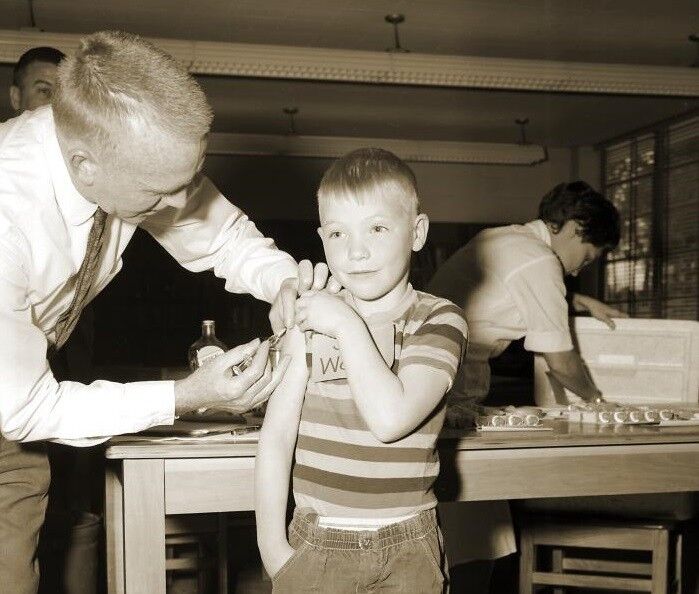
In 1905, American pathologist Ludvig Hektoen reviewed the evidence for the experimental transmission of measles throughout the available literature up to that time. What he found during his review is numerous instances of the failure to transmit the disease through the use of the blood, tears, nasal mucous, lung fluid, and the discharge from measles scabs. To start his review, Hektoen cast doubt on the results of the first attempts to transmit measles via inoculation by Francis Hume in 1758. He quoted Erasmus Darwin, a respected physician of the time, who stated that attempts had been made to transmit the disease, yet there was much difficulty in doing so. Hektoen reported that, in 1816, Thomassen A. Thuessin and his pupil C.J. Themmen tried to recreate Hume’s experiments and ended up producing entirely negative results in their attempts to transmit the disease to five children using the blood of measles patients. Hektoen then proceeded to look at the experimental results of various other researchers over the 19th century.
- In 1801, Chapman tried to transmit measles using the blood, tears, the mucus of the nostrils and bronchia, and the eruptive matter in the cuticle without any success.
- In 1809, Willan fared the same result when he tried unsuccessfully to inoculate three children with vesicle fluids.
- In 1810, Wachsel attempted to inoculate an 18-year-old with measles, but this was said to be doubtful and was considered a “natural” infection rather than an experimental one based upon the length of time it took for the symptoms to develop.
- In 1822, Dr. Frigori tried to infect six children without success as the symptoms were considered non-specific. Not content with his results, Dr. Frigori attempted to infect himself, also without success.
- That same year, Dr. Negri tried to infect two boys and suffered the same negative results as Dr. Frigori.
- Also, in 1822, Speranza failed in his attempts to infect four boys with measles using similar methods.
- In 1834, Albers attempted to infect four children without success. He quoted Alexander Monro, Bourgois, and Spray (Spry?) as also having made unsuccessful inoculations with saliva, tears, and cutaneous scales.
- Finally, in 1890, Hugh Thompson tried to infect two sets of children on separate occasions, both without success.
Experimental Measles
“The first attempt at inoculation of measles of which we have
any record was made by Francis Home, in 1758.”
“According to his own records Home attempted to inoculate measles in 15 different persons, and he concludes that in most instances he succeeded in producing the disease in a mild and modified form.”
“Judging from the following quotation Erasmus Darwin was either not familiar or not favorably impressed with Home’s work:
. . . . it is probable that inoculation might disarm the measles as much
as the small pox, by preventing the catarrh, and frequent pulmonary inflammation, which attends this disease; both of which are probably the consequence of the immediate application of the contagious miasmata to these membranes. Some attempts have been made, but a difficulty seems to arise in giving the disease; the blood, I conjecture, would not infect, nor the tears; perhaps the mucous discharge from the nostrils might succeed; or a drop of warm water put on the eruptions, and scraped off again with the edge of a lancet; or if moistened with a little warm water? Further experiments of this kind would be worthy the public attention.”
“This opinion was greatly strengthened by the wholly negative results of Themmen’s own experiments. He placed blood of measles patients, taken at the height of the exanthem upon small wounds on the arms of two children; cotton saturated with the tears of a measles patient upon a ruptured vesicle on the arm of an infant; in another case a similar experiment was made with cotton soaked in the perspiration of a patient thickly covered with the eruption of measles; and in the fifth experiment he placed cotton soaked in the tears of a patient with measles upon the intact skin of each arm of a girl. “Though all these things were performed cautiously and in accordance with the precepts of the authorities, yet we saw no effects therefrom, and these five children, although they had not previously been attacked with measles, remained entirely free from this disease,”says Themmen, who acknowledges, however, that the children were apparently not very susceptible to measles because they all lived in houses in which measles was prevalent and yet remained free from the disease.”
“Willan inoculated three children with the fluid of miliary vesicles in measles but without success. And Chapman in Philadelphia in 1801 tried in vain to inoculate measles by means of blood, tears, the mucus of the nostrils and bronchia, the eruptive matter in the cuticle, properly moistened.” On this account Dewes thought that the contagious nature of measles could be fairly disputed.”
“Mr. Wachsel’s experiment on Richard Brookes, a lad of 18, reported by Willan (loc. cit.) is stated by Hugh Thompson and others to have been successful, but this is, to say the very least, exceedingly doubtful. The boy was inoculated January 6, 1810, with cowpox and with fluid taken from measly vesicles. The cowpock was fully developed on the 15th. On the 22d, coughing, sneezing, and running at the eyes set in with chills followed by measly eruption on the 28th–22 days after inoculation. In the light of our present knowledge the measles in this case must be ascribed to a natural infection received about eight days after the inoculation.”
“In 1822 Speranza of Mantua caused inoculation of measles to be made with results regarded by him as eminently successful and so accepted without reserve by several subsequent writers. Speranza describes these inoculations as follows:
“. . . . we invited to perform the operation Dr. Frigori, staff physician of the Workhouse and Convalescent Hospital, where measles was always prevalent among the children. A slight incision was made with the lancet upon a group of the more inflamed disease-spots, and with the point of the instrument charged with the bloody matter several incisions were made on the arm of a healthy person, the wounds being covered at once with a bandage. This operation was performed, with the greatest care and under our observation, upon six boys of different ages. The boys complained, a few days afterwards, of not feeling well; about the fifth or sixth days there appeared very slight traces of cold in the head, with cough and watery eyes, which remained after the appearance of a few exanthematic spots; there was very slight febrile irritation, in some cases a mild diarrhea, and by the ninth or the tenth day after the inoculation the measles had run its course without leaving any trace of secondary malady. Dr. Frigori, not content with this result, to which he had given close and daily observation, tried the experiment upon himself; the outcome was the same, but still milder, the morbid phenomena being merely a passing catarrhal affection, involving the frontal sinuses, and the pituitary membrane rather than the trachea and bronchi. A similar inoculation performed by Dr. Negri upon two boys had the result, as did our own experiments upon four other individuals, carried out in the same way. We were not equally fortunate when following the practice of Home, of Horst, and of Ronalds; that is in saturating a little cotton with the blood from an incision upon a group of exanthematic spots, and applying it to the arm before any puncture had been made. This was attempted in two cases, but the experiment did not fulfil our wishes; no catarrhal phenomena and no exanthematic spots appeared.
Speranza also states that-
In the year 1806, during the prevalence of an epidemic of measles in Parma, Dr. Rasori, staff physician of the Hospital, inoculated one of his nephews with the disease by introducing with a needle, bloody matter taken from the exanthematic sores of an infected person. The formation of papillae at the point of inoculation, with slight traces of catarrhal irritation, and immunity from the epidemic then general, were the result of this salutary operation.
From the description given by Speranza of the symptoms in
the inoculated persons it would seem very doubtful, indeed, if any of them really had measles. And if the symptoms described be accepted as those of “a mild and morbillious affection,” how may natural infection be excluded when we are told that measles was always prevalent among the children in the hospital and when the incubation period is given as five to six days? Under these circumstances I cannot see how it is possible to read any value into Speranza’s experiments.”
“In 1834, Albers without success inoculated four persons using Home’s method in two, and the method of vaccination in two, the blood being taken on the second day of the eruption. Prom this he concludes that the blood does not contain the contagion of measles. He quotes Alexander Monro, Bourgois and Spray (Spry?) as having made unsuccessful inoculations with saliva, tears, and cutaneous scales, but no references are given.”
“Hugh Thompson in Glasgow accepts the inoculations of Home Wachsel, Speranza, and Katona as successful. He regards the practicability and the safety of inoculation in measles, as well as its production of a much milder attack than the spontaneous, as definitely established, and recommends that the method employed be superficial scarification followed by the application of the fluid from blisters on the skin of measles patients. In two instances
however, in which Thompson practiced this method his inoculations failed.”
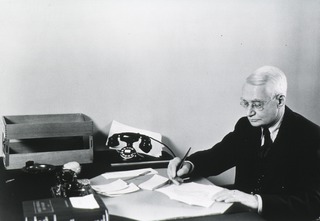
The rest of Ludvig Hektoen’s paper details his own experiments performed in 1905 attempting to infect healthy people with measles. These experiments are considered the definitive proof that measles can be transmitted via the fluids of an “infected” patient. While Hektoen claimed to infect these people with the blood of measles patients, what he used was far more than just the blood. Briefly, two flasks with ascites broth 50 c.c. (peptone broth two parts, ascitic fluid heated to 55° C. for 54 minutes one part) were inoculated with one and three c.c. of blood and incubated at 37° C. for 24 hours. He then made subcultures upon ascites agar, glycerin agar, and Loeffler’s serum. These broths were injected into two patients who were recovering from scarlett fever (a disease said to be mistaken with measles) who experienced some non-specific symptoms that were then claimed to be measles. While this experiment is said to be the definitive proof that a measles “virus” was transmitted from the blood of sick patients to those who are healthy, the fact that the “healthy” subjects were patients that had recently suffered similar symptoms of disease, the blood samples were mixed with other substances such as ascites broth, and the subjects only suffered from mild non-specific symptoms of disease, challenges the validity of Hektoen’s own findings:
PERSONAL EXPERIMENTS.
“In these experiments special care has been taken to exclude
natural infection.
1. The blood injected was taken from a boy of nine who in the later stages of desquamation after an uncomplicated attack of scarlet fever developed a rather mild but typical attack of measles. The first symptoms of measles appeared after he had been free from fever for about two weeks. There was headache, coryza, cough, running of the eyes, and mild febrile symptoms. Three days later a papular eruption was noted and on the fourth day a typical rubeolous rash was present, that soon began to fade and was followed by typical branny desquamation.
On the fourth day (see Chart I) four c.c. of blood were withdrawn from the vein at the right elbow after carefully scrubbing the skin with soap and water followed with alcohol. Two flasks with ascites broth 50 c.c. (peptone broth two parts, ascitic fluid heated to 55° O. for 54 minutes one part) were inoculated 1 at once with one and three c.c. of blood respectively and placed in the incubator at 37° O. for 24 hours. At the end of this time both flasks appeared sterile, the corpuscles having settled, the supernatant fluid being clear. Subcultures made at this time upon ascites agar, glycerin agar, and Loeffler’s serum and kept under aerobic and anaerobic conditions remained sterile; and the contents of the flask of ascites-broth containing one c.c. of blood remained permanently sterile. Four c.c. of the flask of 50 c.c. of ascites-broth mixed with three c.c, of blood and kept in the incubator at 37° 0 for 24 hours were injected under the skin of the chest of a healthy medical student 24 years old,just finishing desquamation after an uncomplicated attack of scarlet fever, and who readily gave his consent to the experiment. This man was not in the same hospital as the boy furnishing the blood for injection, but had been for 26 days in a different institution, at that time as well as before and afterwards entirely free from measles. So far as could be learned, and careful inquiry was made, the man injected had not had any disease at all resembling measles except scarlet fever.
At no time did any local symptoms appear at the site of the injection. On the 13th day after injection the temperature was 101° F; the next morning it rose to 103 (see Chart II). At nine the following morning he was given a warm bath and immediately afterwards a red, papular, blotchy eruption broke out on the forehead and spread quite rapidly to the face, neck and chest. Dr. James B. Herrick who saw him at this time felt no hesitancy in making the diagnosis of measles. By two o’clock an unmistakably typical full-blown, rubeolous rash was present over the greater part of the body. The temperature remained above normal for two days, when it fell to normal about the same time that the eruption began to fade. An uneventful recovery promptly followed without any
complications whatsoever, the desquamation being branny. There was during the entire illness freedom from respiratory symptoms of all kinds. Even during the pre-eruptive period there were no special local symptoms (morbilli sine catarrho). The patient’s subjective condition was not much changed if at all at any time during his illness. The appetite continued unimpaired.
2. In this case the blood was furnished by a well-developed Irish servant girl, 21 years old, who passed through an uncomplicated attack of typical measles (Ohart III). About 30 hours after the earliest appearance of the rash, which still was coming out upon the extremities, 10 c.c, of blood were withdrawn from a vein at the elbow and distributed equally among four flasks each containing 50 c.c, of broth and 25 c.c, of ascites fluid. These flasks all remained perfectly sterile so far as bacteria demonstrable by the usual methods are concerned.
After 24 hours at 37° C. five c.c. of the mixture of blood in ascites-broth were injected subcutaneously in the back of
M, aged 28, who had not had measles so far as he knew and consented to the experiment.
This patient was also recovering from a mild attack of scarlet fever and had been at the time of inoculation for 24 days the sole occupant of the isolation room of a general hospital in which at that time there were no other cases of measles. There were no local changes at the site of the injection. The temperature and general condition remained normal until the evening of the 11th day when the temperature rose to 99.8° F. and the next day a mild conjunctivitis already suspected a day or so previously became definitely apparent. On the 13th day there was some cough, the tonsils were bright and red, and there was an increased amount of mucus in the throat. In the afternoon the temperature which was rising, reached 103° F. (Chart IV). During the next night a typical rubeolous eruption came out, the first spots being noticed on the nose and then on the forehead, face, scalp, chest, back and abdomen. The rash
consisted of pink macules and papules which disappeared readily on pressure, being largest and brightest red over the face. The forehead was quite uniformly red. The patient was not seriously ill; there was some loss of appetite, but he slept well during the night, having been somewhat restless the preceding night. Recovery was prompt.
Cultures of the blood on the 13th day (one c.c. of blood in each of three flasks each containing 50 c.c, of broth and 25 c.c, of ascites fluid) remained permanently sterile.
CONCLUSIONS.
The results of these two experiments permit the conclusion that the virus of measles is present in the blood of patients with typical’measles sometime at least during the first 30 hours of the eruption; furthermore that the virus retains its virulence for at least 24 hours when such blood is inoculated into ascites broth and kept at 37° C. This demonstration shows that it is not difficult to obtain the virus of measles unmixed with other microbes and in such form that it may be studied by various methods.
https://www.jstor.org/stable/30071821?seq=5
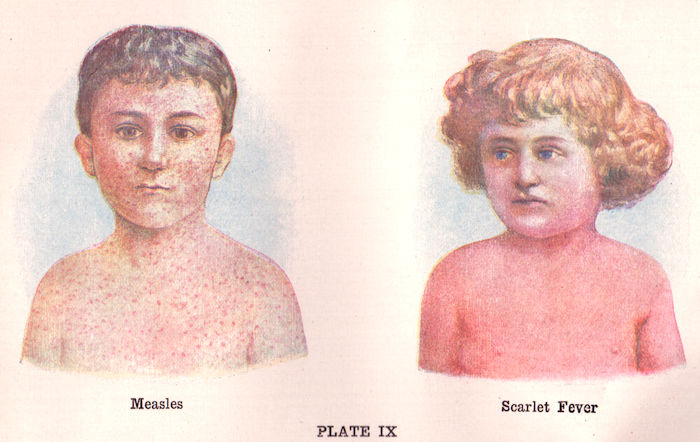
While Hektoen’s findings are questionable on their own, the work of Andrew Sellards a little over a decade later further destroyed the credibility of Hektoen’s claims. During the winter months of 1918 to 1919, Andrew Sellards attempted to recreate the results obtained by Hektoen. To do so, he inoculated the blood of measles patients in 8 healthy volunteers without a prior history of measles exposure. Sellards utilized the same methods as Hektoen and carried out a series of progressively more intense injections of blood. He started with just the blood of a patient obtained 12 hours after eruption that was mixed with 9 parts of isotonic salt solution and then inoculated subcutaneously into a volunteer. No symptoms followed.
In the next series, the blood of a measles patient obtained 12 hours after a rash was either incubated in ascitic broth or defibrinated. Both preparations were injected into 2 volunteers subcutaneously. However, no symptoms occurred in these series of experiments. Thus, more intensive injections took place. Blood was taken in citrate from 2 pre-eruptive measles cases, mixed together, and then injected both subcutaneously and intramuscularly into 2 more volunteers. Twenty-four hours later, the same process was repeated with the same volunteers. However, no symptoms occurred. After 3 weeks, these same volunteers were exposed to an early measles case and had secretions inoculated into their mucus membranes. The volunteers continued to remain symptom free.
After these failures, a final intense injection was attempted using the whole blood of a measles patient that was inoculated subcutaneously and intravenously into another volunteer. This volunteer also remained symptom free. Sellards concluded that his 8 successive failures to transmit measles through successive injections of blood cast doubt on Hektoen’s results, which supposedly showed the transmission of measles via injections of blood. Sadly, I could not copy and paste the highlights from this study for some reason, thus we have to rely on my excellent cropping and underlining skills:
A Review of the Investigations Concerning the Etiology of Measles

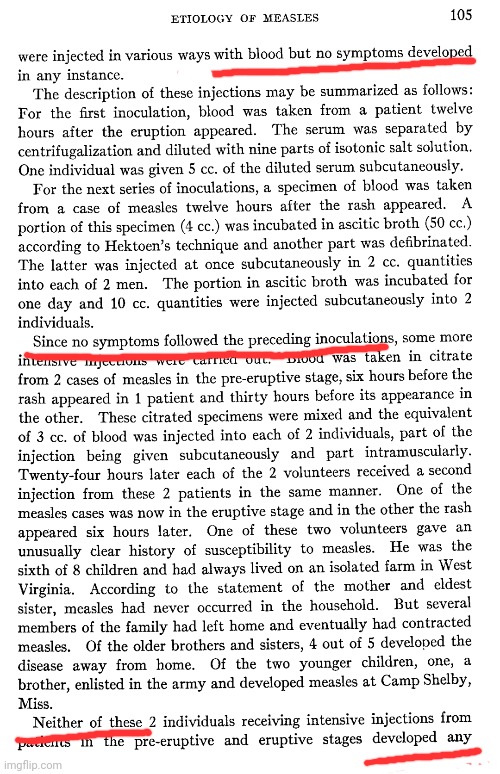
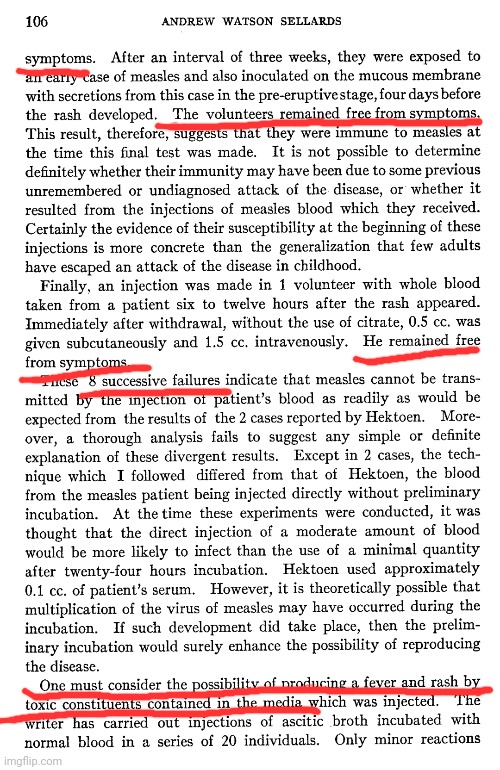
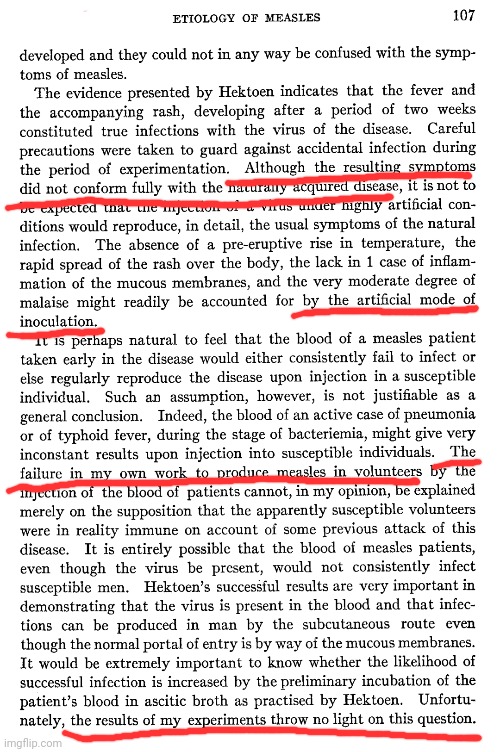
doi:10.1097/00005792-192403020-00001
In 1919, Alfred F Hess M.D. sent a letter to the editor Journal of theAmerican Medical Association in response to Sellards experimental results. In it, he compared both Sellard’s failure to transmit measles to humans with the blood and mucus secretions with his own failure to do so with chickenpox. Hess admitted that the artificial transmission of man was not as nature intended. Sadly, instead of admitting that the “viral” hypothesis is wrong, Hess felt that they were either failing to carry over the “virus” or that there was a different route of infection that was unknown to researchers:
Need of Further Reaserach on the Transmissibility of Measles and Varicella
“It is remarkable that Sellards was unable to produce this highly infectious disease by means of the blood or the nasal secretion of infected individuals. Not long ago, however, I had a similar experience with varicella (Am. J. Dis. Child. 16:34 [July] 1918). Thus we are confronted with two diseases—the two most infectious of the endemic diseases in this part of the world—which we are unable to transmit artificially from man to man. The result was most surprising in regard to chickenpox, and if the same rule holds good for measles it would seem as if a basic principle must be involved. Evidently in our experiments we do not, as we believe, pursue nature’s mode of transmission; either we fail to carry over the virus, or the path of infection is quite different from what it is commonly thought to be.”
https://jamanetwork.com/journals/jama/article-abstract/222413
Animal Experiments
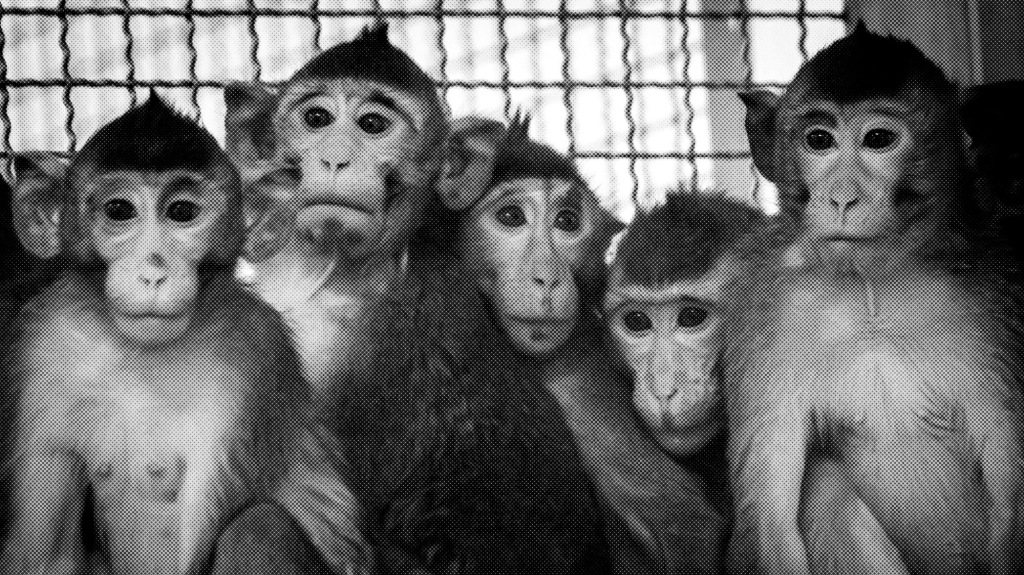
After decades of unsuccessfully trying to prove the infectivity of measles in humans with many different experiments, scientists moved on to trying to infect monkeys. We can find out quite a bit about these experiments by returning to Andrew Sellards 1919 paper. Starting off, Sellards admitted that the results of these animal experiments varied rather remarkably. In the first experiments discussed, Sellards began by looking to the work of Anderson and Goldberger in 1911. Unfortunately, much of the vital information from these experiments was missing and/or not available. The researchers used 3 different species of monkeys in their experiments that experienced only very mild symptoms, with many experiencing no symptoms at all. Two monkeys were inoculated on the mucous membrane with material taken from measles patients 24 hours after symptoms developed, and neither monkey suffered any symptoms. In experiments with subcutaneous injections of patient materials into the monkeys, 4 of 6 attempts were considered unsuccessful.
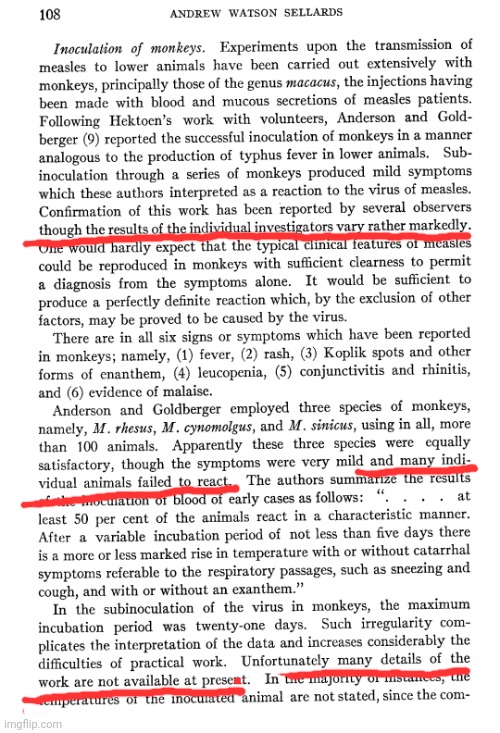
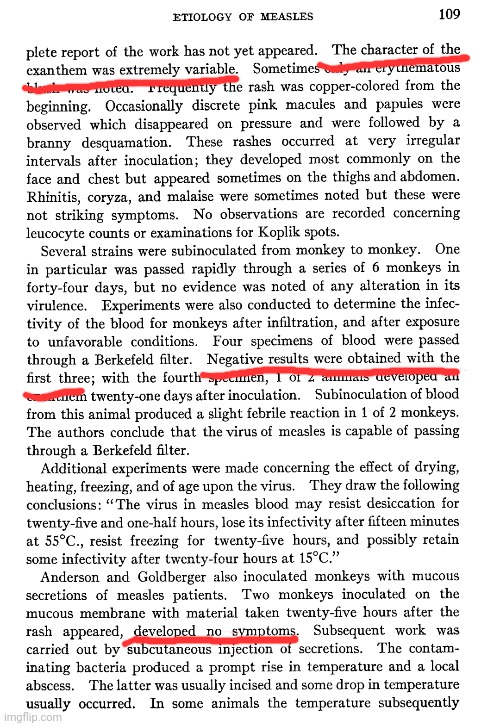
Hektoen and Eggers inoculated two monkeys with the blood taken 24 hours after the rash appeared. No rash or respiratory complications were observed in either monkey. The researchers claimed that their results, when combined with those obtained from Anderson and Goldberger, indicated that monkey’s were susceptible to a “mild kind of measles.”
Lucas and Pfizer had two monkeys injected with the blood of a measles patient. No rash nor any febrile reactions occurred in either monkey. Sellards stated that any interpretation from their experimental results was difficult as several control monkeys died after inoculation as well as some of those inoculated with the “virus” two weeks after the injection of measles blood.
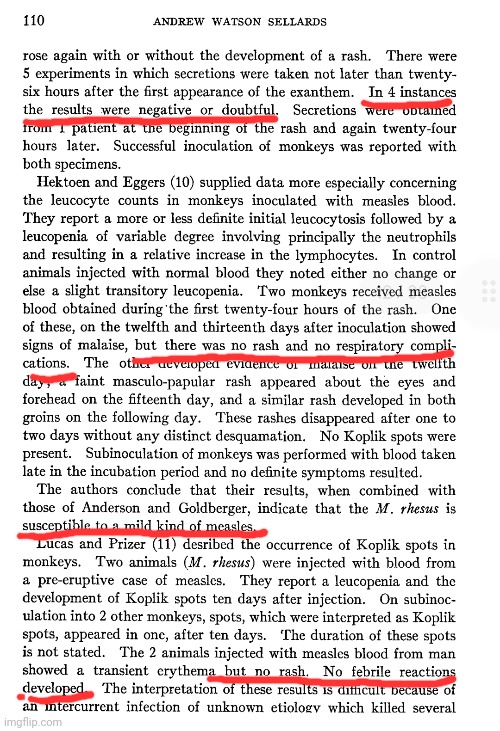
In 1911, Nicolle and Conseil claimed that they had confirmed the work of Anderson and Golderg. However, when one monkey was injected with the blood taken from a measles patient, no symptoms developed beyond a rise in temperature. Blood from this monkey was injected into another monkey that remained entirely normal.
In 1920, the same researchers reported on results from experiments conducted in 1913 where the transfer of measles was attempted from a child to monkeys, re-inoculated into a child, and again into the monkeys. This resulted in the monkeys experiencing no symptoms other than a febrile reaction. No normal baseline temperature ranges for the monkeys were reported, nor were any of the symptoms experienced by the child described. Sellards felt that it was inadvisable to draw any conclusions from these results as such important information was missing.
Tunnicliff inoculated the blood of a measles patient into a monkey that resulted in no definite febrile reactions, no rash, no Koplik spots, nor any other indication of measles in the “infected” monkey.

In 1914, Jurgelunas tried to produce measles in monkeys using inoculations of the blood and mucus secretions from measles patients as well as by exposing the animals to patients in measles wards. He concluded that all of his results were negative.
One monkey injected with defibrinated blood ultimately formed a rash and died 11 days after injection. However, Jurgelunas considered that the rash did not conform to that seen in measles, and therefore, measles was not the cause of death. Another monkey was injected with blood aquired 24 hours after the rash appeared in the measles patient, and no symptoms developed. A third monkey, injected with blood taken from the second day after the rash appeared, also developed no symptoms.
Two monkeys were exposed to patients in the measles wards, spending five days with acute patients and two days with covalescent patients. Neither developed any symptoms. Several other experiments were carried out in other monkeys with mucous secretions from measles patients, which all yielded negative results.
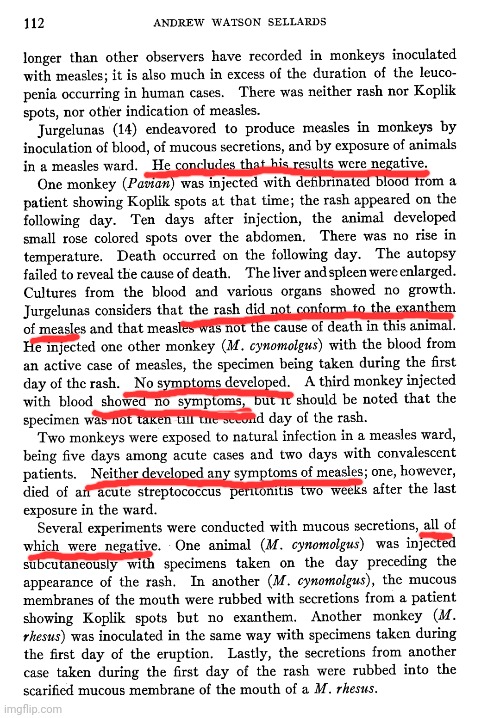
In 1921, Blake and Trask claimed that they had successfully infected 8 out of 10 monkeys with measles, thus “confirming” the work of Anderson and Goldberger, Hektoen and Eggers, and Lucas and Pfizer. However, the rash that appeared did not differ from rashes that occur in monkeys without measles, and febrile reactions only occurred in those animals that were inoculated with contaminated materials.
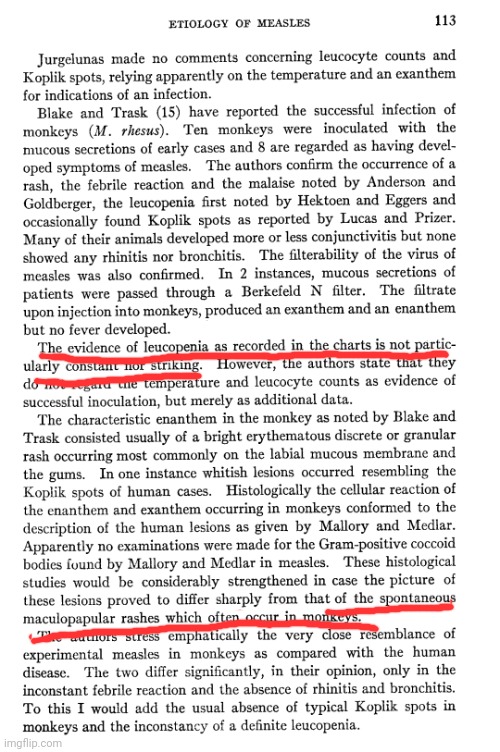
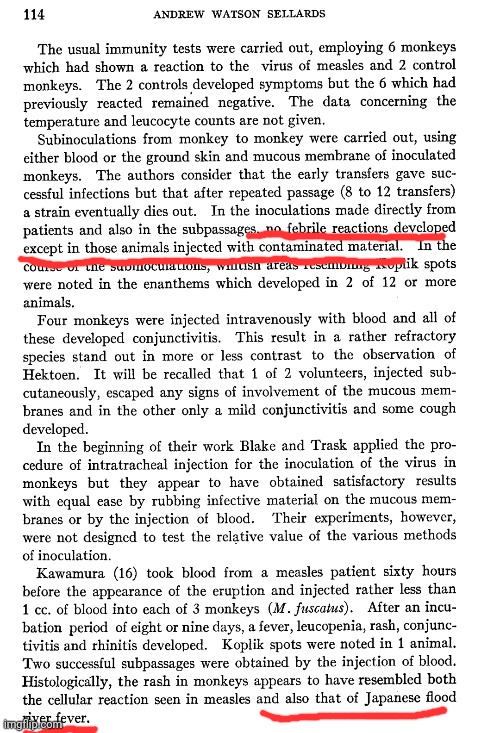
In 1918 and 1919, Sellards and Wenworth inoculated 3 monkeys in various ways, including intensive injections of blood from measles patients. The animals remained well without any evidence of measles, even under favorable conditions meant to bring about the disease.
In a separate experiment, blood from measles patients was injected simultaneously into 2 men and 2 monkeys. Both men remained symptom-free. One of the two monkeys developed symptoms that were not suggestive of measles, and as the two men remained healthy, Sellards concluded that the monkey was not suffering from a measles “virus.” Sellards also mentioned that his own experiments using mucous secretions only resulted in negative findings and that the injection of the blood from measles patients has not conclusively demonstrated measles infection.
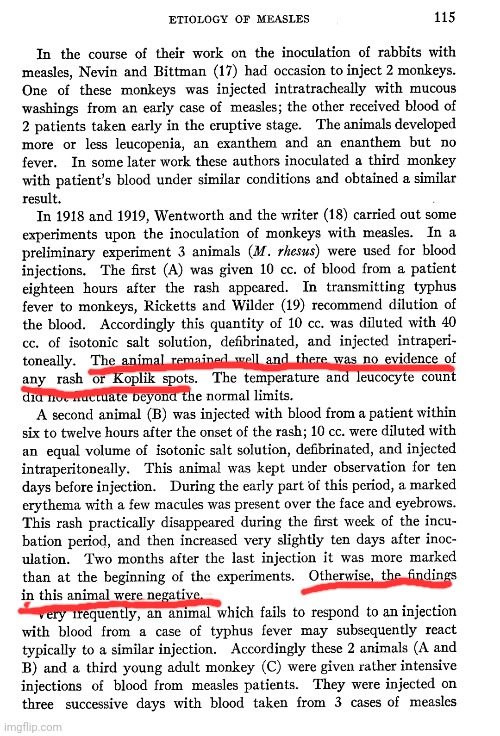
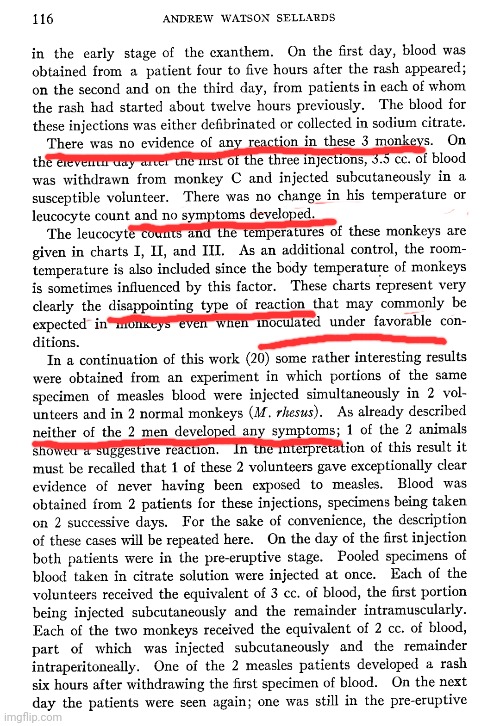
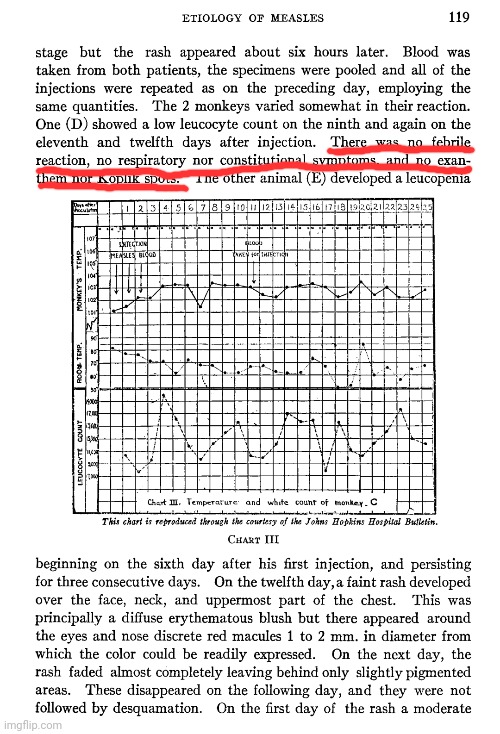
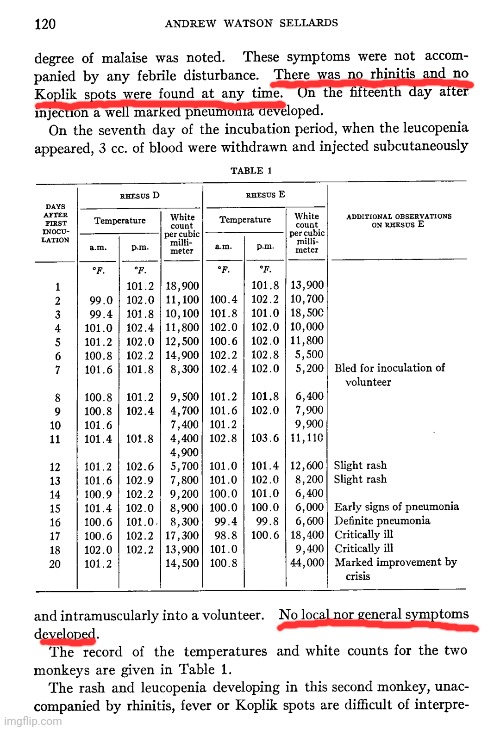
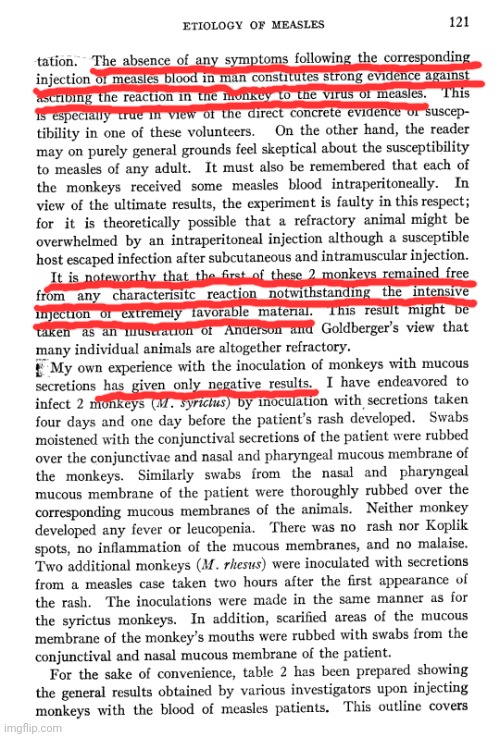
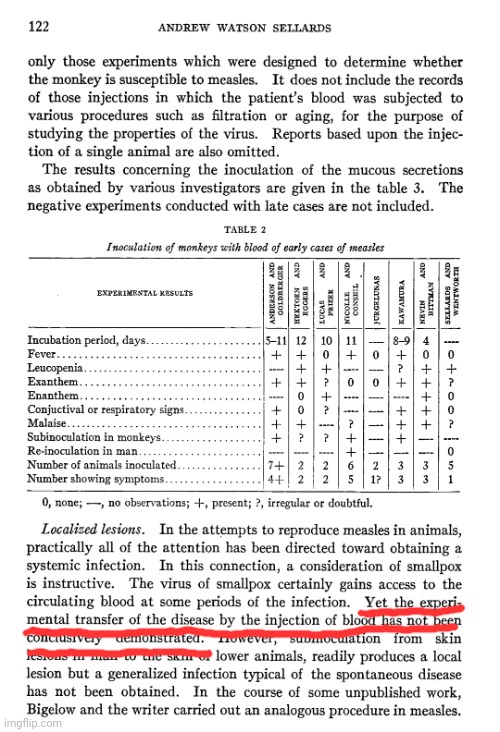
Regarding his own experimental results, as well as taking into account those from researchers before him, Sellards concluded that there was no exact proof of the susceptibility of monkeys to measles. He considered that using the reactions in monkeys as a way of studying measles was unsatisfactory. He also considered the filterability of the “virus” an entirely open question.
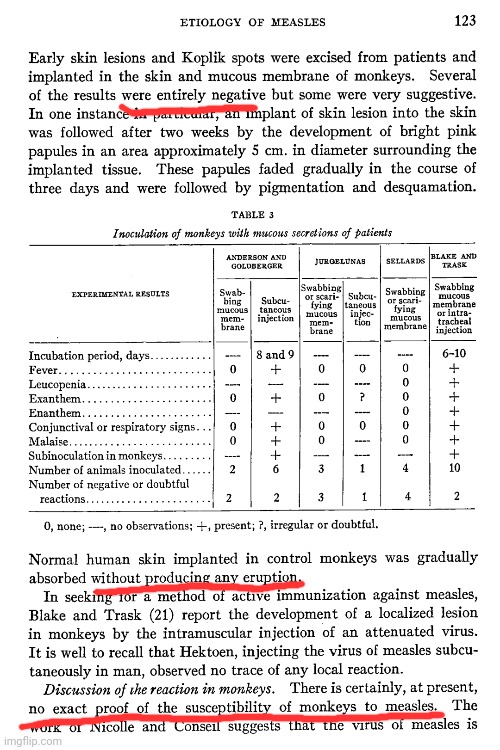
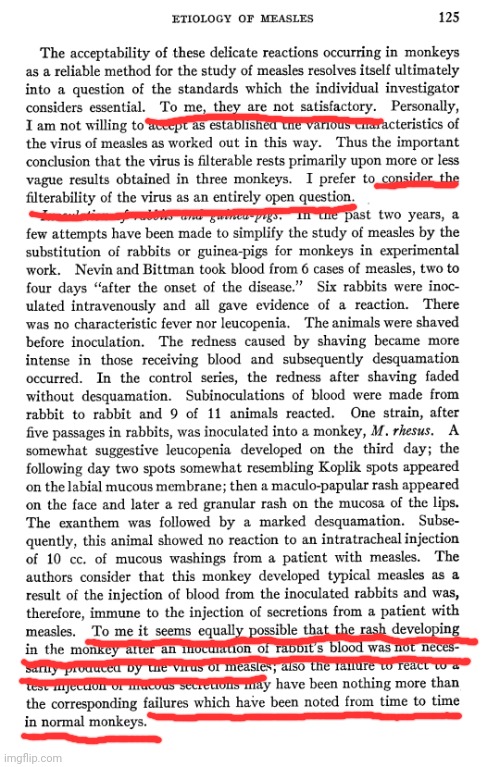
Grund injected rabbits intratrachaelly with mucous secretions from measles patients. Of the 23 animals experimented on, a large number remained without illness. No febrile reaction or leucopenia emerged, and immunity tests were contradictory. Grund concluded that no one individual animal gave a typical picture of measles.
While Duval and D’Aunoy believed that they had reproduced measles by injecting the blood of measles patients into rabbits, Sellards concluded that their findings would require extensive confirmation and elaborate controls in order to confirm. The researchers also studied guinea pigs and believed them susceptible to measles. However, some of the essential data was not present in their report, with incomplete information on temperature and leucocyte counts that would not lead one to logically come to the same conclusion.
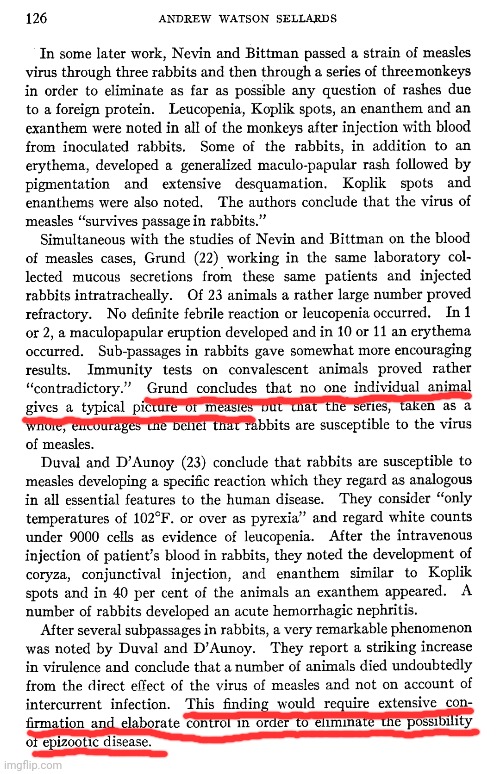
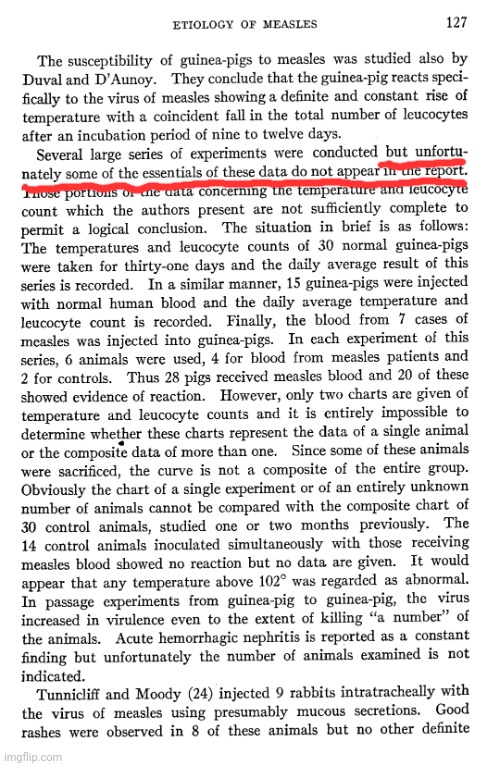
Tunnicliff and Moody injected 9 rabbits intratrachaelly with mucous secretions, and while rashes were observed in 8 of them, no other definite symptoms developed.
Kawamura used blood from monkeys that were inoculated with the blood from measles patients and then attempted to transmit disease from the monkey to both guinea pigs and rabbits without success.
Nicolle and Consil concluded that rabbits and guinea pigs were not susceptible to measles after attempting to inoculate these animals unsuccessfully.
Based upon the experimental results of others, Sellards concluded that symptoms in rabbits were even less definite than those seen in monkeys. Thus, he believed that accepting rabbits and guinea pigs as susceptible to measles, or even that the “virus” could survive within these animals, was not warranted based upon the evidence submitted.
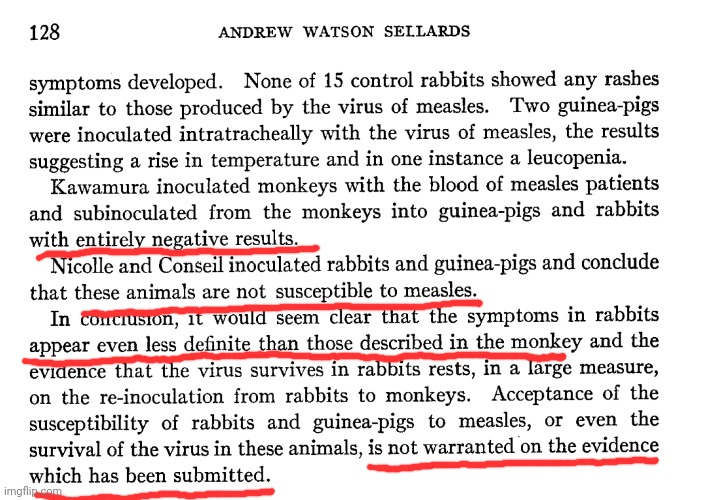
When discussing the transmission of measles to man, Sellards stated that injecting the blood of a measles patient, where the “virus” was assumed to reside, into a healthy subject, does not mean that one will acquire measles. He reiterated that his own work involving the injection of the blood of measles patients into healthy subjects only produced negative results.
On the transmission of measles into animals, Sellards stated that there was no convincing proof of the susceptibility of monkeys to a measles “virus.” He felt that all observers agreed that the symptoms produced in monkey experiments were rather vague and that experienced investigators reported conflicting results and marked variations. No matter what the mode of inoculation, the interpretation of the results remained the chief difficulty. The experimental reactions were too mild to determine that they were the result of a measles “virus” from the human patient. Sellards believed that it was important to come to an exact method of study for all future research rather than pile up a massive amount of data that was reliant upon one or two doubtful methods. He concluded by stating that the cardinal problems remaining to be solved for measles were:
- The demonstration of the causative microorganism
- The cultivation of the microorganism
- The experimental recreation of the disease in animals
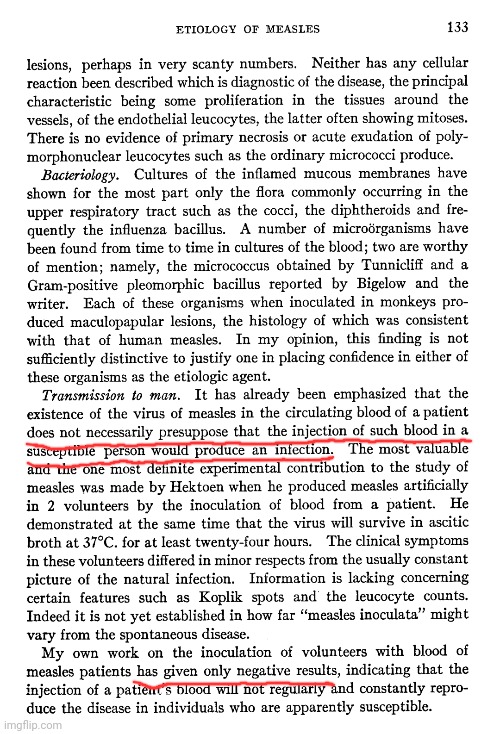
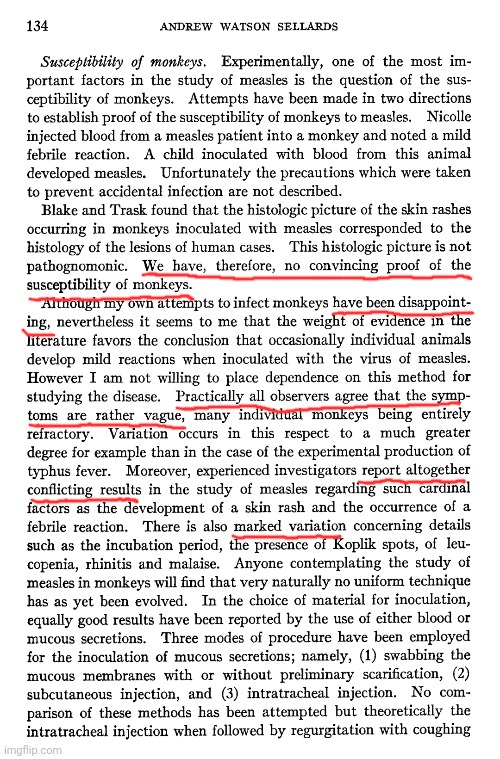
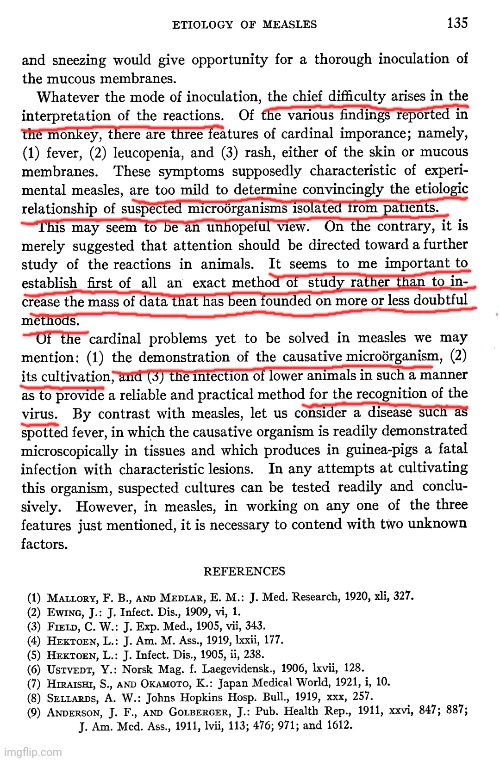
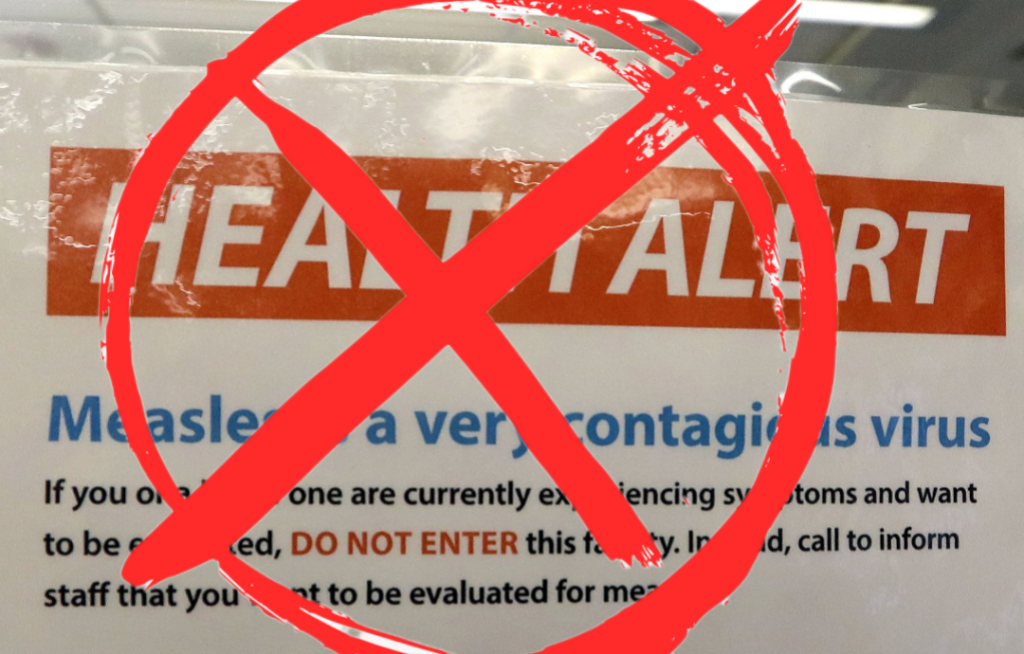
In Summary:
- In 1758, Francis Home attempted the first inoculations of measles fluids into patients and concluded that in most instances, he succeeded in producing the disease in a mild and modified form
- However, Erasmus Darwin was not impressed with the results and stated that some attempts had been made, but a difficulty seemed to arise in giving the disease
- C. J. Themmen’s own experiments using the tears, sweat, and other fluids from measles patients on 5 children were all negative
- Chapman in Philadelphia in 1801 tried in vain to inoculate measles by means of blood, tears, the mucus of the nostrils and bronchia, the eruptive matter in the cuticlewithout success
- In 1809, Willan inoculated three children with the fluid of miliary vesicles in measles but without success
- In 1810, Wachsel attempted to inoculate an 18-year-old with measles, but this was said to be doubtful and was considered a “natural” infection rather than an experimental one based upon the length of time it took for the symptoms to develop
- In 1822, Dr. Frigori tried to infect 6 children with measles which produced mild non-specific symptoms, but they did not develop measles
- Frigori was not satisfied with the results and attempted to infect himself without success
- In 1822, Dr. Negri tried to infect two children with measles and came up with the same negative results as Dr. Frigori
- In 1822, Speranza attempted to infect 4 children using similar methods, but without success
- In 1834, Albers tried to infect four children with measles, 2 in the way of Home, and 2 by way of vaccination, and none of the 4 fell ill
- Albers quoted Alexander Monro, Bourgois and Spray as having made unsuccessful inoculations with saliva, tears, and cutaneous scales
- In 1890, Hugh Thompson attempted to inoculate 2 children with measles and failed in both instances
- In 1905, Ludvig Hektoen attempted to infect 2 healthy people with measles using the blood of sick patients
- To do so, he used two flasks with ascites broth 50 c.c.(peptone broth two parts, ascitic fluid heated to 55° C. for 54 minutes one part) that were inoculated with one and three c.c. of blood and incubated at 37° C. for 24 hours
- He then made subcultures upon ascites agar, glycerin agar, and Loeffler’s serum
- This was injected into the two volunteers, who were both recently recovering from similar symptoms with scarlett fever, who experienced non-specific symptoms that were questionable as to whether they experienced measles
- During the winter months of 1918 to 1919, Andrew Sellards attempted to recreate the results obtained by Hektoen
- To do so, he inoculated the blood of measles patients in 8 healthy volunteers without prior history of measles exposure, starting with just the blood of a patient obtained 12 hours after eruption that was mixed with 9 parts of isotonic salt solution and then inoculated subcutaneously into a volunteer, and yet no symptoms followed
- In the next series by Sellards, the blood of a measles patient obtained 12 hours after a rash was either incubated in ascitic broth or defibrinated
- Both preparations were injected into 2 volunteers subcutaneously, and, once again, no symptoms occurred in these series of experiments
- More intensive injections took place as blood was taken in citrate from 2 pre-eruptive measles cases, mixed together,and then injected both subcutaneously and intramuscularly into 2 more volunteers and repeated twenty-four hours later
- However, no symptoms occurred, and after 3 weeks, these same volunteers were exposed to an early measles case and had secretions inoculated into their mucus membranes and continued to remain symptom free
- In 1919, Alfred F Hess M.D. sent a letter to the editor Journal of the American Medical Association in response to Sellards experimental results, stating that “it is remarkable that Sellards was unable to produce this highly infectious disease by means of the blood or the nasal secretion of infected individuals.”
- Hess was unable to do the same with chickenpox and declared that “we are confronted with two diseases—the two most infectious of the endemic diseases in this part of the world—which we are unable to transmit artificially from man to man.”
- Turning to animal experiments, Sellards admitted that the results of experimental infection of measles with monkeys varied rather remarkably
- Sellards bgan by looking at the work of Anderson and Goldberger in 1911, where much of the vital information from these experiments was missing or not available
- The researchers used 3 different species of monkeys that experienced only very mild symptoms, with many experiencing no symptoms at all
- Hektoen and Eggers inoculated two monkeys with the blood taken 24 hours after the rash appeared, and no rash or respiratory complications were observed in either monkey
- The researchers claimed that their results, when combined with those obtained from Anderson and Goldberg, indicated that monkey’s were susceptible to a “mild kind of measles“
- Lucas and Pfizer had two monkeys injected with the blood of a measles patient, and no rash nor any febrile reactions occurred in either monkey
- Sellards stated that any interpretation from their experimental results was difficult as several control monkeys died after inoculation as well as some of those inoculated with the “virus” two weeks after the injection of measles blood
- In 1911, Nicolle and Conseil claimed that they had confirmed the work of Anderson and Golderger
- However, when one monkey was injected with the blood taken from a measles patient, no symptoms developed beyond a rise in temperature
- Blood from this monkey was injected into another monkey that remained entirely normal
- In 1920, the same researchers reported on results from experiments conducted in 1913 where the transfer of measles was attempted from a child to monkeys, re-inoculated into a child, and again into the monkeys
- This resulted in the monkeys experiencing no symptoms other than a febrile reaction
- No normal baseline temperature ranges for the monkeys were reported, nor were any of the symptoms experienced by the child described, and thus, Sellard felt that it was inadvisable to draw any conclusions from these results as such important information was missing
- Tunnicliff inoculated the blood of a measles patient into a monkey that resulted in no definite febrile reactions, no rash, no Koplik spots, nor any other indication of measlesin the “infected” monkey
- Jurgelunas tried to produce measles in monkeys using inoculations of the blood and mucus secretions from measles patients as well as by exposing the animals in to patients measles wards, and had to conclude that all of his results were negative
- One monkey injected with defibrinated blood ultimately formed a rash and died 11 days after injection, yet Jurgelunas considered that the rash did not conform to that seen in measles, and therefore, measles was not the cause of death
- Another monkey was injected with blood aquired 24 hours after the rash appeared in the measles patient, and no symptoms developed
- A third monkey injected with blood taken from the second day after the rash appeared also developed no symptoms
- Two monkeys were exposed to patients in the measles wards, spending five days with acute patients and two days with covalescent patients, and neither developed any symptoms
- Several other experiments were carried out in other monkeys with mucous secretions from measles patients, which all yielded negative results
- In 1921, Blake and Trask claimed that they had successfully infected 8 out of 10 monkeys with measles, thus “confirming” the work of Anderson and Goldberger, Hektoen and Eggers, and Lucas and Pfizer, yet the rash that appeared did not differ from rashes that occur in monkeys without measlesand febrile reactions only occurred in those animals that were inoculated with contaminated materials
- In 1918 and 1919, Sellards and Wenworth inoculated 3 monkeys in various ways, including intensive injections of blood from measles patients, and the animals remained well without any evidence of measles, even under favorable conditions meant to bring about the disease
- In a separate experiment, blood from measles patients was injected simultaneously into 2 men and two monkeys, with both men remaining symptom-free, and only one of the two monkeys developing symptoms that were not suggestive of measles
- As the two men remained healthy, Sellards concluded that the monkey was not suffering from a measles “virus”
- Sellards also mentioned that his own experiments using mucous secretions only resulted in negative findings that the injection of the blood from measles patients has not conclusively demonstrated measles infection
- Regarding his own experimental results, as well as taking into account those from researchers before him, Sellards concluded that there was no exact proof of the susceptibility of monkeys to measles
- He considered that using the reactions in monkeys as a way of studying measles was unsatisfactory
- He also considered the filterability of the “virus” an entirely open question
- Grund injected rabbits intratrachaelly with mucous secretions from measles patients, and of the 23 animals experimented on, a large number remained without illness
- No febrile reaction or leucopenia emerged, and immunity tests were contradictory
- Grund concluded that no one individual animal gave a typical picture of measles
- While Duval and D’Aunoy believed that they had reproduced measles by injecting the blood of measles patients into rabbits, Sellards concluded that their findings would require extensive confirmation and elaborate controls in order to confirm
- The researchers also studied guinea pigs and believed them susceptible to measles, but some of the essential data was not present in their report, with incomplete information on temperature and leucocyte counts that would not lead one to logically come to the same conclusion
- Tunnicliff and Moody injected 9 rabbits intratrachaelly with mucous secretions, and while rashes were observed in 8 of them, no other definite symptoms developed
- Kawamura used blood from monkeys that were inoculated with the blood from measles patients and then attempted to transmit disease from the monkey to both guinea pigs and rabbits without success
- Nicolle and Consil concluded that rabbits and guinea pigs were not susceptible to measles after attempting to inoculate these animals unsuccessfully
- Based upon the experimental results of others, Sellards concluded that symptoms in rabbits were even less definite than those seen in monkeys
- Thus, he believed that accepting rabbits and guinea pigs as susceptible to measles, or even that the “virus” could survive within these animals, was not warranted based upon the evidence submitted
- When discussing the transmission of measles to man, Sellards stated that injecting the blood of a measles patient, where the “virus” was assumed to reside, into a healthy subject, does not mean that one will acquire measles
- He reiterated that his own work involving the injection of the blood of measles into healthy subjects only produced negative results
- On the transmission of measles into animals, Sellards stated that there was no convincing proof of the susceptibility of monkeys to a measles “virus”
- He felt that all observers agreed that the symptoms produced in monkey experiments were rather vague and that experienced investigators reported conflicting results and marked variations
- No matter what the mode of inoculation, the interpretation of the results remained the chief difficulty
- The experimental reactions were too mild to determine that they were the result of a measles “virus” from the human patient
- Sellards believed that it was important to come to an exact method of study for all future research rather than pile up a massive amount of data that was reliant upon one or two doubtful methods
- He concluded by stating that the cardinal problems remaining to be solved for measles were:
- The demonstration of the causative microorganism
- The cultivation of the microorganism
- The experimental recreation of the disease in animals
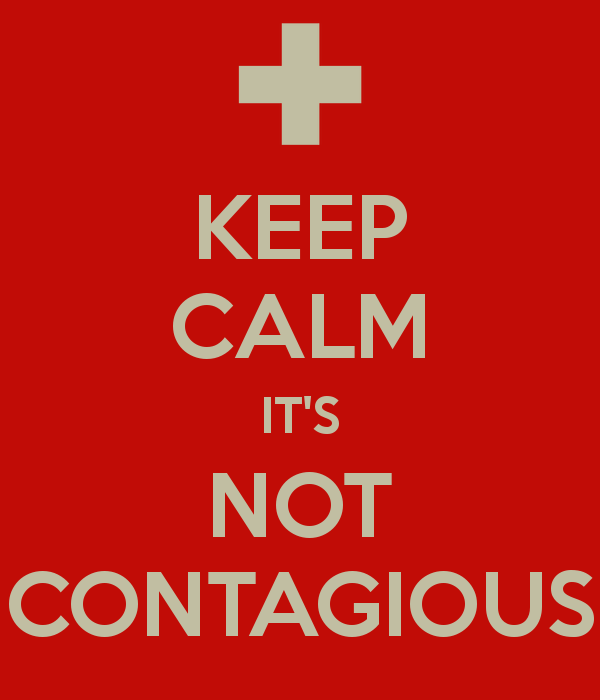
Somewhere along the line, the non-specific symptoms referred to as measles went from being known as a benign childhood disease to a highly contagious killer of children. However, the foundational experimental evidence does not show this to be the case. Not only were the deaths associated with measles falling throughout the 20th century prior to the introduction of any vaccine, the human and animal experiments used to show that there was a “highly contagious viral” cause demonstrated the exact opposite. Researchers repeatedly failed to recreate the same symptoms of disease using every possible source of fluids from a measles patient. In many instances, no symptoms ever occurred, and in the few instances where symptoms did occur, they were not the same as those seen naturally. Thus, these experiments failed to show any sort of “highly contagious and infectious virus.” In fact, they showed that a disease such as measles can not be transmitted from one person to another via the fluids. They showed, once again, that the infectious myth had been busted.





